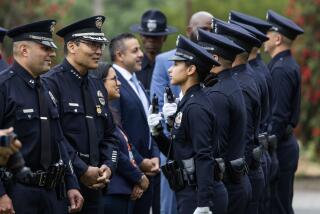Police Capping Their Pens on Fender-Bender Reports
- Share via
With all that San Diego police have to investigate--bank robberies, serial killings, auto burglary, drug dealing, gang shootings and the like--fender-benders just haven’t ranked very high.
Now they don’t rank at all.
With a shortage of manpower in the Police Department, officers no longer will investigate traffic accidents in which nobody is injured.
Starting Saturday, police still will be instructed to go to the scene of an accident. But, if nobody is hurt, each driver involved will get an information card that can be exchanged with other drivers and submitted to insurance companies.
Police will then skip writing their own reports and leave the scene to respond to more serious calls, officials said.
Under the new order from Police Chief Bob Burgreen, police will continue to write reports for all traffic collisions in which injuries occur or, for insurance purposes, those in which city vehicles or city property are damaged.
It is the second time in four years that San Diego police have stopped responding to minor traffic calls.
For the first four months of 1987, the department began dispatching civilian community service officers to non-injury traffic accidents because patrol officers had more serious matters to investigate. Once a new police academy class graduated that year, the department resumed sending officers to all accident scenes.
But now, even community service officers are too busy to respond.
Burgreen’s announcement is the second in two weeks involving a shift in manpower. Earlier this month, Burgreen said he was placing about 30 detectives and support officers back into uniform because so much of his force was devoted to keeping the peace at protests involving war in the Persian Gulf.
There may be more staffing changes to come.
“I think it’s safe to say we’ll be looking at an allocation distribution for all our resources in the months ahead,” said Assistant Chief Norm Stamper.
“We had no increase in staffing this year, and we have to be realistic about our financial situation,” he said.
Police administrators say the department is getting too many calls for too few officers.
The size of the force has risen over the past few years, but the city’s growth--and the number of calls for help that have accompanied it--have far outpaced it. The department handled 1.5 million calls in 1987, 1.7 million in 1988 and 1.8 million in 1989. Last year, the number dipped to 1.75 million.
In 1990, the department responded to 17,300 non-injury traffic accidents. By the department’s calculations, it takes an officer about 45 minutes to respond to such a call and to draft an accident report.
The department estimates that it can free up the time of seven or eight full-time officers by not responding to fender-bender-type accidents, said Capt. Nancy Goodrich, head of the traffic division.
Goodrich said the department will undoubtedly get a few complaints about the new procedure, which she said is permanent.
“I can understand the complaints,” she said. “I can also understand that some people would not appreciate waiting four to six hours in the middle of the night waiting for an officer to respond to a burglary because someone’s writing accident reports.”
More to Read
Sign up for Essential California
The most important California stories and recommendations in your inbox every morning.
You may occasionally receive promotional content from the Los Angeles Times.













